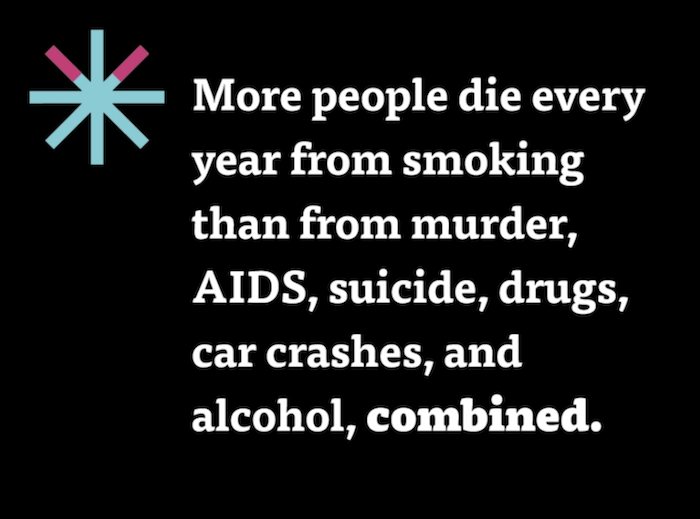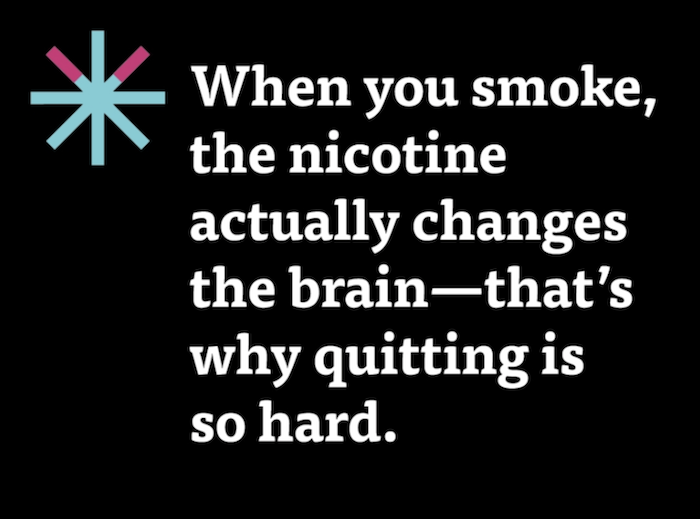On December 6, the Department of Justice (DOJ) announced that tobacco companies would be required to post signs in retail stores warning about the dangers of smoking.
The order concludes a long-standing civil racketeering lawsuit by the government against the largest US cigarette companies, which has been held up to varying degrees in court ever since 1999. It’s set to go into effect on July 1, 2023, and gives the relevant manufacturers—Altria, Philip Morris USA, R.J. Reynolds and ITG Brands (a subsidiary of Imperial)—a further three months to post the mandated “corrective statements.”
“Justice Department attorneys have worked diligently for over 20 years to hold accountable the tobacco companies that defrauded consumers about the health risks of smoking,” Vanita Gupta, the associate attorney general, said in a press statement. “Today’s resolution implements the last remedy of this litigation to ensure that consumers know the true dangers of the smoking products they may consider purchasing.”
The signs include statements like: “More people die every year from smoking than from murder, AIDS, suicide, drugs, car crashes, and alcohol, combined”; and “Smoking is highly addictive. Nicotine is the addictive drug in tobacco.”

“It is critical that we use our expertise and the full power of the law to protect Americans from tobacco-related disease and death,” Brian King, the director of the FDA’s Center for Tobacco Products (CTP), said in a press statement about the DOJ’s action. “Today’s order further emphasizes the federal government’s commitment to take whatever steps that are necessary to protect public health, including preventing false and misleading labeling and advertising by manufacturers.”
It’s in the area of relative risk, among others, that some experts feel an opportunity to provide truly helpful information to the public has been lost.
Cliff Douglas, now the director of the University of Michigan Tobacco Research Network, likely helped to originate the lawsuit many years ago, working with a journalist and a Reynolds whistleblower to show that tobacco companies had for decades been deliberately manipulating the nicotine content in cigarettes to dependence-forming levels.
He told Filter that the move was “not without significance.” But he stressed it was key to highlight this could help end smoking-related disease and death, as other forms of tobacco—like snus—carry far fewer harms than combustible cigarettes.
“It’s important to recognize that the original court decision, and the industry behavior it addressed, predated the emergence of e-cigarettes in the United States, and the mandated corrective statements importantly highlight the priority of dramatically reducing combustible tobacco use,” Douglas added.
But it’s in the area of relative risk, among others, that some experts feel an opportunity to provide truly helpful information to the public has been lost. One of the statements that will soon adorn retail outlets merely offers, for example: “It’s not easy to quit.” In line with federal agencies’ stance, it adds nothing about harm reduction, and options ranging from nicotine replacement therapy to—still more effective—e-cigarettes.

Another of the statements, reminiscent of the FDA’s misleading anti-youth vaping campaigns, reads: “When you smoke, the nicotine actually changes the brain—that’s why quitting is so hard.” (All psychoactive substances temporarily affect the brain, but implications beyond that would be disputed by many scientists.)

The statements’ heavy emphasis on nicotine—which does not, in the absence of tar, cause serious harms—will disappoint harm reductionists. But the messages have US public health authorities’ fingerprints all over them.
King, who has frequently described his short tenure as CTP director as a “baptism by blowtorch,” has come under fire for how adult nicotine users remain misinformed about relative risks. Before he had even assumed his new role, tobacco harm reduction (THR) advocates pointed out that King, as a higher-up at the Centers for Disease Control and Prevention (CDC), was largely responsible for the misconception that “EVALI”—the string of vaping-related illnesses that cropped up in the fall of 2019—was linked to nicotine.
Though the CDC belatedly admitted to have found a “very strong culprit” for the “e-cigarette or vaping product use-associated lung injuries”—vitamin E acetate, a cutting agent found in some illicit THC cartridges—it still has not bothered to drop “e-cigarette” from the name, let alone firmly correct the record. There has been repeated pressure to do so from some leading experts in tobacco control.
At the E-Cigarette Summit in May, many delegates took the opportunity to remind Matthew Holman—then the top scientist at CTP, but who would soon leave the FDA to work for Philip Morris International (PMI)—why the public is so massively misinformed about the relative risks of vapes and cigarettes. A recent study found that 60 percent of doctors believed all “tobacco” products to be equally harmful.
“If it formed the basis for truth-telling about the risky and safer options, it would actually be useful.”
On December 8, in a separate case, a federal judge blocked the FDA from enforcing a rule that would require tobacco companies to put graphic warning labels on cigarette packs—the latest episode in a lengthy battle between manufacturers like Reynolds and the agency, which had finally intended to put the rule into effect in November 2023 after more than a decade of legal and logistical hurdles. The tobacco producers most recently fought the rule with a First Amendment challenge.
Clive Bates, a THR advocate and former director of Action on Smoking and Health (ASH) in the United Kingdom, has previously called such labeling “essentially a stigmatizing measure designed to make smokers feel stupid and to force them to parade it as they smoke.” That’s on the basis that just about everyone believes—rightly—that cigarettes are deadly. What most people still don’t know is that vapes and other nicotine options are not.
Bates reacted similarly to the “corrective statements” that will soon be widespread in US stores. “Obviously it’s all about pointless symbolism and victories of style over substance,” he told Filter. “If it formed the basis for truth-telling about the risky and safer options, it would actually be useful. But that opportunity will definitely be squandered.”
Top photograph by Lindsay Fox via Flickr/Creative Commons 2.0. Inset graphics via Department of Justice.
The Influence Foundation, which operates Filter, has received grants from Altria, PMI and Reynolds American, Inc. Filter’s Editorial Independence Policy applies.





Show Comments